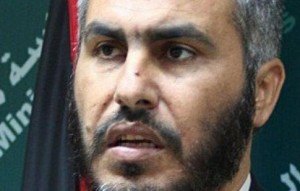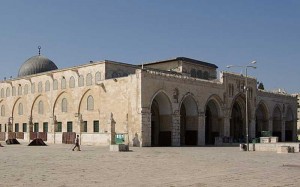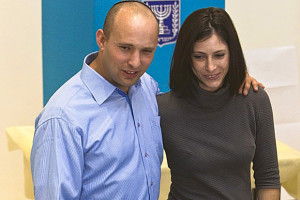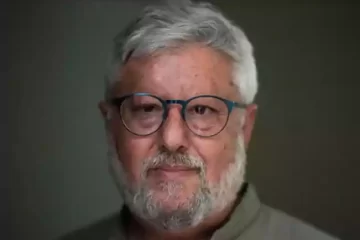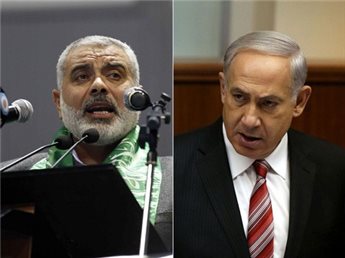This is a very long piece – but every word is important and contains most of what I have been thinking about Hamas over the last years, about our conflict, about peace and about our way forward. It may take a long time to read, but I believe that is has a lot of wisdom that has been generated over a very long period.
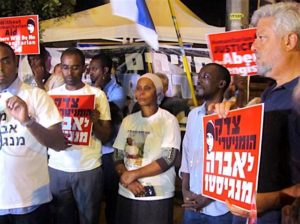
Gershon Baskin joins the Family of Avraham Abera Mengistu to mark two years since his disappearance.
I have negotiated with Hamas, on and off, since 2006. Some of the times I was actually negotiating officially, acting as a private citizen but in full coordination with Israeli authorities. Most of the time I did this without official backing, but always informing officials in Israel what I was doing and seeking to achieve. There was never any Israeli objection to my talks with Hamas leaders. Most of the time I was encouraged to continue to talk with them. Most of the past eight years were focused on attaining the release of the bodies of Israeli soldiers killed in 2014 in Gaza Oron Shaul and Hadar Goldin, as well as the living Israeli civilians Avera Mengisto and Hisham A-Sayed. I have spent hundreds of hours in talks trying to bring them home. Over eight years, progress was made and compromises were accepted by both sides. The bottom line is that the deal never happened because Hamas demanded that among the prisoners that Israel was prepared to release, several hundred, there had to be those serving the longest periods of time in prison. That means Palestinians convicted of killing Israelis. This was a red-line for Israel that would not be crossed. For several years those negotiations have not made any progress.
When I understood that the negotiations were at a point of unbreakable deadlock, I tried other tactics. The Israeli officials proposed that I suggest to Hamas economic incentives – water, electricity, even cash payments. Hamas responded that those issues are not connected to prisoners and that they should be granted regardless of the prisoner issue because they are basic human rights and should be provided under Israel’s responsibility as it controls, together with Egypt, all of Gaza’s external borders. I then thought that we should try what is done in classic negotiations theory – expanding the pie. I proposed that we go back to what I tried to do in 2012 which abruptly ended with the assassination by Israel of Ahmad Jabaari, the head of the Hamas military wing. At that time, Ghazi Hamad from Hamas and I were drafting texts for a proposed long-term ceasefire and opening the civilian blockade of Gaza. We had gone through several drafts, one of which I shared with then Minister of Defense Ehud Barak and with the special envoy of the UN Secretary General. On the morning that Jaabri received the last draft we were working on; he was assassinated by Israel. Jaabri was the key person behind the abduction and the captivity of Gilad Schalit. I retrieved that draft from my computer and shared it once again with Hamad in Gaza about two years ago and since then I have tried to convince him to spend a few days with me either in Norway, Switzerland or Egypt where we would brainstorm on how to change the relations between Israel and Gaza. Hamad initially agreed to meet and I was making arrangements for him to be able to travel to Norway. The Norwegian authorities sent someone to Gaza to speak with him and he grew scared that too many people knew that he would be traveling to meet me. It turns out that the Norwegian Foreign Minister decided that she had to inform the Israelis about the planned meeting in Norway, and then I canceled the plans and told the Norwegian officials that we would not be meeting.
I then made plans for us to meet in Switzerland. I received an invitation from a Swiss NGO for Ghazi Hamad, as the Swiss authorities requested so that they could prepare a national visa for him only for Switzerland. I told Hamad that we would tell the Swiss that we would be meeting in Geneva, when the actual plan was for us to meet in a private flat in another Swiss city. But Hamad grew scared and suspicious and said that he did not receive permission to meet me in Europe from Yehya Sinwar – the head of Hamas in Gaza. Over the past months I kept pushing him to meet with me in Cairo and that no one had to know about it. He said that he could not. I think that by that time he must have been privy to the secret of an impending military attack on Israel – that is my assessment. This does not mean that he knew all of the details of what was planned and implemented, but I believe that the Al Qassam forces could not have done what they did without the knowledge and agreement of the top political leadership in Gaza.
For years I believed that it could have been possible to negotiate a long-term hudna/ceasefire agreement with Hamas that would/could have opened the siege on Gaza and reintegrated Gaza into the economy of the West Bank, Israel and the world. Students from Gaza could have attended universities in the West Bank or around the world. Doctors could have come to Gaza and treat cancer patients in Gaza’s hospitals. New businesses could have been opened. The more than 2 million people in Gaza could have had some kind of horizon of a better life. Young people could have had some hope of seeing the world, not solely on the screens of their phones. There were seven working universities and colleges in Gaza before this war but no work for the graduates. There was more than 60% unemployment of young people in Gaza and even those who were employed did not make enough money to escape poverty.
Keeping Gaza poor and under Hamas’ control was part of the strategy developed by Netanyahu and implemented with the attitude that a weakened Hamas served Israel’s interests in having a government controlling half of the Palestinian people that was dedicated to destroying Israel. So, Netanyahu even facilitated and allowed for the funding of Hamas’ rule with cash coming from a state that supports Hamas and the Muslim brotherhood openly – Qatar. In conjunction with the policy of delegitimizing the rule of Mahmoud Abbas in the West Bank, but allowing and encouraging the preservation of enough capital and other interests in the West Bank to promise that the Palestinian Authority would continue to coordinate security with Israel, Netanyahu’s strategy of preventing pressure on Israel to deal with the Palestinian issue was completely implemented. The Palestinian Authority in the eyes of most Palestinians worked for Israel and protected settlers while providing no security for Palestinians. The PA lost most of its legitimacy in the eyes of most Palestinians years ago. This political split with Hamas on one side and the Palestinian Authority on the other, enabled Israel to continue to claim that there is no partner for peace, while Netanyahu and other Israelis, including Bennett, Gantz, Lapid and basically the entire Israeli leadership, stated that they would not engage in any peace process with the Palestinians. The Abraham Accords then completely removed the Palestinian issue from the Israeli agenda which did not appear at all in any of the repeated rounds of Israeli elections. Since Olmert’s attempts to negotiate with the Palestinians in 2008, there have been no serious Israeli efforts to find solutions on how to live together in relative peace on the Land between the River and the Sea.
This confortable situation for Israeli society for two decades has enabled settlements to expand with Israeli taking control over more and more land in the West Bank. Netanyahu promised the US that he would not build new settlements – so they built “new neighborhoods” of existing settlements, some many kilometers away from the existing settlements. Wild, violent, religious fanatic settlers took possession of Palestinian owned land and continued to push Palestinians off their land. Violence against Palestinians and vandalism against Palestinian property increased all protected by the Israeli army and border police. Palestinian violence, in Jenin, Nablus and elsewhere, organized and also by individuals was a natural response against Israeli tactics to expel Palestinians from Palestine – all right out of the text book of Smootrich and Ben Gvir, with Netanyahu at their side. The straw that broke the camel’s back – the one that always unites Palestinians, Arabs and Muslims against Israel is what they perceive to be the attacks against Al Aqsa. The constant changing of the “status quo” which is that Al Aqsa – the whole of the Haram a-Sharif/Temple Mount compound is for Muslim prayer only and the Kotel is for Jewish prayer is perceived by Palestinians and Muslims to be part of a grand scheme of Israel to remove the Mosques and to rebuild the Temple. Israeli assurances that this is not going to happen are not believed and the Tomb of the Patriarchs in Hebron is the example that they give to show how the Jews took possession of the place and with force divided the holy place with plans to eventually prohibit Muslims from praying there. Al Aqsa is the raw “nuclear” nerve of the Israeli-Palestinian conflict and when it is touched, explosions happen.
There is no legitimacy whatsoever for what Hamas and others did inside of Israel on October 7. These were inhuman, inexcusable crimes that will never be forgotten or forgiven. Hamas has earned the place of losing its right to exist as a government of any territory and especially the territory next to Israel. It is very doubtful that if Palestinian elections were held prior to October 7 that Hamas would have gained more than 30% of the vote – even less in Gaza than in the West Bank because in Gaza they have experience of 17 years of Hamas rule. Hamas behaved like ISIS in their attack against Israel, and even though Hamas is not ISIS (there are many differences between them) Hamas has fully earned the determination of Israel to eliminate them as the political and military body that controls Gaza.
We Israelis must begin to finally confront the delusion that we have been living for decades with almost total acceptance. It should become clear to us all that you cannot occupy another people for 56 years and expect to have peace. You cannot lock more than 2 million people into what is a human cage and expect to have quiet. 17,000 Palestinian workers in Israel was a good start by the Bennett-Lapid government, but it is much too few and much too late to begin to change the reality in Gaza and to create real interests in keeping relative calm. The failed conceptualization that Hamas has been deterred is finally being understood but for the wrong reasons. I have spoken against the idea of the possibility of deterring Hamas during and after every round of fighting with Hamas and Islamic Jihad in Gaza. I have repeatedly said in the Israeli Television studios that Israel cannot create deterrence against Hamas. Not only are Hamas fighters and leaders not afraid to die, they recruit Hamas fighters from early ages from bereaved families immediately after each round of conflict. They are then educated in the (distorted) Islamic values of dying for Palestine, for Allah, for Islam, for Al Aqsa and to get revenge for the death of their father, brother, mother, sister, etc. They truly believe that life on earth is short and only has true meaning if you become a martyr, a shaheed for Allah, Palestine, Al Aqsa, Islam and to get revenge. Becoming a shaheed is the guarantee to eternal paradise which is so much more important that the short life in this world. How can you build deterrence against this? But the retired generals in the TV studios never agreed and never listened, as well as the generals and politicians who make the real decisions about what Israel does.
Can Hamas be dismantled and destroyed?
The government and military control of Gaza by Hamas can be dismantled and destroyed. It will not be easy and the human costs will be great. Israel has for sure developed plans for how to smoke or gas the Hamas fighters and leaders out of the web of tunnels underneath the entire Gaza strip. If Israeli civilian hostages – the children, women, elderly, wounded and sick are not brought out under an agreement with Hamas, they will be at risk of death with all of the hostages that Israel considers soldiers. Hamas already claims that 50 hostages have been killed in Israeli bombings. We have no way to know if this is psychological warfare or the truth. There is great pressure on Israel to meet its moral responsibility to bring home all of the hostages because of the failure of Israel to provide security and protection for these citizens – which is the primary and most important duty of any state. While some important Israeli leaders have said that Israel should empty its prisons out of all Palestinian prisoners and send them to Gaza in exchange for all of the hostages, this seems very unlikely to happen. Israel seems to be exhausting every possible avenue to bring home the civilian hostages, but eventually the military incursion into Gaza will happen in full force.
I believe that Israel should agree to a ceasefire to allow for the civilian hostages to be freed. Israel can agree to allow fuel trucks into Gaza for the hospitals only accompanied by United Nations non-Palestinian personnel who will stay with the trucks and then stay at the hospitals to ensure that the fuel will not be stolen by Hamas. We should now allow for this issue to prevent the possibility of retrieving the majority of the hostages through agreement. It is not clear that Hamas is prepared for such a deal. It is not clear that Hamas has control over all of the hostages. It is not clear that Qatar is speaking to the people who are holding the hostages. It is more likely that Egypt has the ability to speak to the Al-Qassam people who are holding most of the hostages. I have spoken to Hamas political leaders in Gaza, Beirut and Doha. My sense is that they are not in control and their demands or statements on what they want are not consistent and probably cannot be trusted. It is a very complex situation. The fact that it is also not 100% clear who is the interlocutor for this on the Israeli side is also a complicating factor. It seems that Gal Hirsch is not in charge as the coordinator for missing Israelis. He does not seem to have the confidence of the War Cabinet and I have heard that even Netanyahu is not really engaging with him. I have grown tired of Israeli statements that “we are doing everything possible to return the hostages – leaving no stone unturned.” I heard it for five years when Shalit was in captivity when I knew that for very long periods of months and even more than a year, no negotiations were taking place at all. I have heard the same thing for years about Oron Shaul, Hadar Goldin, Avera Mengisto and Hisham A-Sayed.
So, I believe that sooner or later Israel will enter Gaza with a huge force. Many hostages may be rescued, many others may not. Many soldiers will be at risk as well. All of the people who are holding hostages will be killed. Maybe there will be some who don’t actually want to die and maybe some of them will hand hostages over to Israel. If they do, they will be granted amnesty and free passage and money to leave to wherever they want to go. Every person who had something to do directly with the capture and captivity of Gilad Shalit is no longer alive. That will be the fate of almost everyone responsible for what happened in Israel on October 7.
My final words in this (too) long article is to the people of Gaza, to the Palestinian people, and to all of us Israelis. My heart bleeds for all of the innocent people of Gaza who have been killed, many of them buried alive under the thousands of homes that have been destroyed by Israeli bombs. War crimes are being committed by Israel in Gaza. Killing innocent people is not “collateral damage.” We are talking about the lives of thousands of people who are victims of this conflict as well, regardless of their political opinions or their views on Hamas. If they are non-combatants, they are innocent victims. The indiscriminate bombings have to end. There will be a day after tomorrow when this war ends. There will still be two peoples living on this land and we will either look back at the horrors of what we have done to each other, or we will begin to look forward. These events are the biggest traumas for Israelis since the Holocaust and for the Palestinians since the Nakba. We will not forget. This will be the new chapters in our collective memories and narratives. The question is will we stand up from the ashes and from the pains and finally realize that everyone living between the River and the Sea must have the same right to the same rights or we will continue to say that only my side has the rights to express our collective identity on this Land?
We must wake up from this trauma and make those who have led us to this point pay the price for their failures. None of our leaders, on both sides should have the legitimacy to stay in power. They all have to go. We, Israelis and Palestinians need new leaders, a new generation who stand up and say “NO MORE!” We need people with new visions, new ideas, new hopes and the ability to generate support of masses of people who start paving a new path. I don’t know if we need to talk about one state, two states, three states or ten states. It begins with the mutual recognition that we all have the same right to the same rights. If we are realistic – it will probably be more talk about two states. If that is the case, two things need to happen quickly – a new peace process has to begin with the end state being up front and loud. If it is two states, then that needs to be clear from the outset, unlike the open-ended failed Oslo process. Secondly, if it is two states, then all of the countries of the world that have voiced the words “two states solution” must finally and immediately recognize the second state. They can do that with conditions, such as, when Palestine holds new elections and elects a new government.
Finally, the following are some thoughts on steps that need to be taken immediately after the war – to some extent, some of this could happen without the massive Israeli incursion into Gaza.
How to end the war with Hamas no longer in control of Gaza
• Without risking wider regional war and destabilization
• Without additional massive civilian casualties in Gaza
• Without risking the collapse of the regimes in the West Bank, Jordan and Egypt
• With the best chance of bringing home as many hostages as possible
Pre-conditions for implementing the plan
• Full US buy-in and lead on the diplomacy – with the use of significant pressure
• Support of Israel (even reluctant with significant arm twisting and persuasion – this is an offer you can’t refuse…)
• Support from President A-Sisi
• Support from King Abdallah
• Support from MBS
• Endorsement of the Arab League
Desired conditions
• Support of President Abbas
• Support of the democratic opposition within Fatah
General Lines of the Plan
The plan is based on prior (not the same) situation of the need to end the civil war in Lebanon
• Ceasefire
• Release of hostages – civilian hostages
• Arab League decision (or just the agreement of several Arab states – Egypt, Saudi Arabia, Jordan, UAE, Bahrain, Morocco, and others) to send a multilateral Arab led force to Gaza with the mandate to take control of the military/security situation in Gaza. Qatar may have to be involved to apply pressure on Hamas to accept.
• Group of Arab states to take on guarantor role agreed to sustain these principles:
• Guarantee of ceasefire
• Timetable for removal of Hamas leadership and/or disarmament
• Issuing a plan for Civilian control of Gaza’s governance, led by the PA which will also hold immediate Parliamentary elections. Parties participating in elections will be only those which agree to the demilitarization of Gaza and the West Bank.
• Prior to those elections a small group of Arab states party to this agreement will agree to take on advisory and trustee role with the PA, interfacing with Israel and the US, and guaranteeing implementation of all agreed aspects of deal.
• Political reforms in the PA supported by the international community (with a lot of money) in which power is transferred from the Presidency to the Parliament from which a government is formed which governs over the West Bank and Gaza. (The shifting of power from the Presidency to the Prime Minister occurred during the Arafat period when the US forced Arafat to surrender powers to Abbas who became Prime Minister).
• A regional/international peace conference advancing progress to Palestinian Israeli agreement towards the eventual implementation of the two states solution.
• A Marshal Plan for the rebuilding of Gaza led by the International Donor Community.
The main question we are addressing is how is it possible to bring about the desired end result of the war (removing Hamas from its ability to rule and threaten Israel) without killing many more civilians in Gaza, lowering the risk to Israeli soldiers, decreasing the chances of destabilization of the regimes of the PA in the West Bank (to avoid uprising of more radical groups there), Jordan and Egypt.
There is probably no way of avoiding the Israeli plans to eliminate the political and military leaders of Hamas. This does not necessarily have to be done at the time of a military incursion into Gaza. Exiling them, model PLO Beirut 1982 seems very unlikely. Who would take them? Wouldn’t they continue to pose a lethal threat to Israel from wherever they relocate.
First steps towards implementing this plan
1. Selling it to the Americans – without American backing first, there is little chance of advancing it.
2. Americans have to bring Israeli support – this will also help to prepare the Israeli public for the plan.
3. Engage with Palestinian leadership in Ramallah regarding the plan and the demand for elections for the Parliament, the forming of a new government for West Bank and Gaza, with a power shift from the President to the Prime Minister (this was done with American pressure to Arafat who was forced to empower Abbas as Prime Minister and Salam Fayyad as Finance Minister)
4. Planning the administration of Gaza with the Palestinian elected leadership – civil service force in Gaza of about 50,000 people who have been on the payroll of Hamas for years and while not combatants have a certain loyalty to Hamas. They should not be fired and sent home – the lesson from Iraq should be learned. Those who are willing and able to work under the new order should remain and receive salaries from the new government.
5. After conducting a series of high level closed door meetings with Arab leaders – US convenes summit of key Arab states: Saudi Arabia, Egypt, Jordan, UAE, Bahrain, Morocco, and maybe Qatar – where the proposed Arab Multi-national force to Gaza is discussed and decided. The mandate of the force must be developed in consultation with the member states, and presented at the summit. It should not be open-ended, must have a planned exit strategy aligned with the resumption of Palestinian control over Gaza reunited with the West Bank.
6. US Convenes multi-nation summit for the reconstruction of Gaza -based on Arab multinational force, with stated political goals of renewing Palestinian-Israeli negotiations with robust international support (particularly regional Arab support – including Saudi promise for full normalization with Israel at the conclusion of the process of reaching agreements between Israel and Palestine.
7. The Israeli-Palestinian process needs to have a stated end game from the outset – whether it is two states or something else – it must be set and stated by the international community without any “constructive ambiguity.” In fact, all partners to this process should declare that they will recognize the State of Palestine at an agreed time based on parameters to be set, e.g. post elections in Palestine and the forming of a new government. Palestinian Israeli negotiations then conducted on the state-to-state basis.
A version in German was published by ZeitpunktMagazin at https://zeitpunkt.ch/die-zukunft-der-hamas-nach-dem-7-oktober-2023-teil-1
A version in Hebrew can be found at https://araby.tv/he/posts/98452
